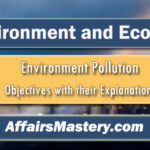Set 1 | Important Environment Issues MCQs
Important Environment Issues MCQs. Environment Issues are pivotal aspects of Environment and Ecology, serving as a cornerstone for success in competitive exams like Civil Services, State exams, SSC, Railways, Banking, and more. Mastering these subjects offers a unique advantage, allowing you to gain invaluable insights into the country’s environmental legacy. With a focus on Environment, Biodiversity, and Ecology, this knowledge not only sharpens your competitive edge but also equips you to excel in these challenging exams.
| MCQs on Environment Issues – Objective Questions and Answers |

Q1. Consider the following statements with reference to the carbon sequestration:
- It is the technology designed to tackle global warming by capturing CO2 and storing it before it is released into the atmosphere.
- Depleted oil reserves, unmineable mines are examples of natural carbon sinks.
- Carbon dioxide can dissolve in liquid like water but not in oil.
Which of the statements given above is/are correct?
[A] 1 only
[B] 2 and 3 only
[C] 1 and 2 only
[D] All of the above
View Explanation
Correct Answer is A.
- Statement 1 (Correct): Carbon capture and storage (CCS) involves technologies to reduce global warming by capturing CO2 from power plants, industrial sites, or the air, and storing it underground. Carbon sequestration is the long-term storage of CO2 to mitigate global warming.
- Statement 2 (Incorrect): Carbon sequestration can involve pumping carbon into natural or artificial carbon sinks, like oceans, forests, and depleted oil reserves. The oil and gas industries have used carbon capture for enhanced recovery for years.
- Statement 3 (Incorrect): CO2 can be trapped as a gas under low-permeability rock, dissolved in liquids like water or oil, or react with minerals to form stable compounds, such as carbonates.
Q2. With reference to National Clean Air Programme (NCAP) Consider the following statements:
- It aims to achieve the 20% to 30% reduction in Particulate Matter concentration by 2034.
- It is prepared by the Ministry of Housing and Urban affairs to reduce PM concentration in the selected smart cities.
Which of the statements given above is/are incorrect?
[A] 1 only
[B] 2 only
[C] Both 1 and 2
[D] Neither 1 nor 2
View Explanation
Correct Answer is C.
- Statement 1 (Incorrect): The Central Government launched the National Clean Air Programme (NCAP) to reduce air pollution nationwide. The goal is to reduce Particulate Matter concentrations by 20% to 30% by 2024, with 2017 as the base year. It targets 122 non-attainment cities that have failed to meet air quality standards from 2014 to 2018. State Pollution Control Boards monitor and report air quality.
- Statement 2 (Incorrect): The Ministry of Environment, Forests, and Climate Change prepared the NCAP.
Q3. Considered the following statements regarding dissolved oxygen:
- Biological Oxygen Demand (BO(D)is a better indicator to measure the concentration of required oxygen as compared to Chemical Oxygen Demand (COD).
- COD measures the concentration of oxygen required for the oxidation of non-biodegradable matters while BOD measures the same for the degradable matter.
- The dissolved oxygen is inversely proportional to the dissolved organic wastes in the water body.
Which of the statements given above is/are incorrect?
[A] 1 and 2 only
[B] 2 only
[C] 1, 2 and 3
[D] None of the above
View Explanation
Correct Answer is B.
- Statement 1 (Correct): Aquatic species need oxygen for decomposition and consumption, and its demand depends on the organic and inorganic waste in the water. More waste decreases dissolved oxygen, increasing the demand for oxygen by aquatic species, known as Biological Oxygen Demand (BOD). Higher BOD indicates lower dissolved oxygen and poorer water quality.
- Statement 2 (Incorrect): Chemical Oxygen Demand (COD) measures the oxygen needed to oxidize both biodegradable and non-biodegradable matter in water.
- Statement 3 (Correct): BOD specifically measures the oxygen required for the decomposition of organic matter, making it a better indicator of aquatic system health.
Q4. Which of the following statements are incorrect regarding the Solid Wastes Management Rules, 2016?
[A] Waste generators are to segregate wastes into three categories: biodegradable, non- biodegradable, and domestic hazardous wastes.
[B] Local authorities and village panchayats are to make suitable waste management plans in accordance with the state government policy.
[C] All manufacturers of disposable products are to provide financial assistance to the local authorities for the setting up of waste disposal systems.
[D] These rules are only applicable to the plains and exempt the hilly and the north eastern states.
View Explanation
Correct Answer is D.
- Statement 1 (Correct): Waste generators must segregate waste into three categories: biodegradable (wet), non-biodegradable (dry), and domestic hazardous waste.
- Statement 2 (Correct): Local authorities and village panchayats are responsible for planning waste disposal according to state government policies.
- Statement 3 (Correct): Manufacturers must financially assist local authorities in setting up waste management facilities.
- Statement 4 (Incorrect): A Central Monitoring Committee under MoEF&CC monitors rule implementation. The rules apply to all local bodies and census towns, and landfills are prohibited in hilly areas.
Q5. Consider the following statements regarding Bioremediation:
- It uses microorganisms or their enzymes to break down pollutants from the environment.
- Marine Microbes Wheat Bran is a hydrocarbon degrading bacterium with the capacity to clear oil spills.
- These microbes do not have a metabolism of their own and rely on the hydrocarbon waste for energy.
Which of the statements given above is/are correct?
[A] 1 and 2 only
[B] 1 only
[C] 1 and 3 only
[D] 2 and 3 only
View Explanation
Correct Answer is A.
- Statement 1 (Correct): Bioremediation involves microorganisms like bacteria or fungi breaking down environmental pollutants into less toxic forms, often using their enzymes.
- Statement 2 (Correct): The National Institute of Ocean Technology (NIOT) developed an eco-friendly crude oil bioremediation technology using consortia of marine microbes and wheat bran (WB) immobilized on agro-residue bacterial cells.
- Statement 3 (Incorrect): Hydrocarbon-degrading bacteria don’t rely on hydrocarbons for survival but use them as a carbon and energy source, aiding in oil spill cleanup.
Q6. Consider the following statements regarding genetically modified organisms:
- Rubber Board research farm has the world’s second genetically modified (GM) rubber plant tailored for the climatic conditions in North-eastern India after China.
- GMOs are living organisms whose genetic material has been artificially manipulated in a laboratory through genetic engineering.
- Clearance of Genetic Engineering Appraisal Committee (GEA(C) is not mandatory for the environmental release of Genetically Modified (GM) crops.
Which of the statements given above is/are correct?
[A] 1 and 3 only
[B] 3 only
[C] 1, 2 and 3
[D] 2 only
View Explanation
Correct Answer is D.
- Statement 1 (Incorrect): A Rubber Board research farm near Guwahati has introduced the world’s first genetically modified (GM) rubber plant, designed for the Northeast’s climate. Natural rubber, native to the warm, humid Amazon forests, is not naturally suited for the colder conditions of the Northeast, a major rubber-producing region in India.
- Statement 2 (Correct): Genetically Modified Organisms (GMOs) are organisms whose genetic material has been artificially manipulated in a lab through genetic engineering, creating gene combinations that do not occur naturally or through traditional crossbreeding.
- Statement 3 (Incorrect): The Genetic Engineering Appraisal Committee (GEAC), established under the Environment (Protection) Act, 1986, must approve the environmental release of GM crops. While GM organisms have mixed effects on the environment, biodiversity, and local communities, BT cotton is the only GM crop currently approved in India. It contains genes from Bacillus thuringiensis (BT), which produce a protein toxic to the pink bollworm pest.
Q7. Which of the following are the environmental consequences of Sand Mining in India?
- Changing the course of the river and increased in river erosion.
- Depletion of groundwater tables.
- Threat to agriculture and damage to coastal ecosystem.
- Adversely impacting the habitat of microorganisms.
Select the correct answer using the codes given below:
[A] 1, 2 and 3 only
[B] 1 and 3 only
[C] 2 and 4 only
[D] All of the above
View Explanation
Correct Answer is D.
- Statement 1 (Correct): Sand and boulders stabilize riverbeds and prevent rivers from changing course. Unregulated sand removal increases erosion, alters riverbeds, and can cause flooding.
- Statement 2 (Correct): Sand on riverbeds connects the river to the water table and is part of the aquifer. Excessive sand mining, such as in Karnataka’s Papagani catchment area, depletes groundwater and harms the environment.
- Statement 3 (Correct): Sand mining reduces agricultural productivity, depletes groundwater, and can dry out farmlands. Coastal sand mining causes coastal erosion, destroys fisheries, and threatens species like the gharial.
- Statement 4 (Correct): Sand dredging disrupts the habitat of essential microorganisms critical to soil structure and fertility.
Q8. With respect to Sand mining, Consider the following statement:
- Sand provides a buffer against strong tidal waves and storms and is used for making glass.
- Due to sand mining, there is revenue forfeiture to the exchequer.
- Sand mining results in an increase of groundwater and enriches the coastal ecosystem.
Which of the statements given above are correct?
[A] 1 and 2 only
[B] 2 and 3 only
[C] 1 and 3 only
[D] All of the above
View Explanation
Correct Answer is A.
- Statement 1 (Correct): Sand is essential for protecting the environment, buffering against tidal waves, providing habitat for marine life, and is used in construction, glass-making, and tourism.
- Statement 2 (Correct): Sand mining involves removing sand and gravel, leading to economic losses, such as an estimated Rs. 1,000 crore loss to the exchequer in Noida and Greater Noida.
- Statement 3 (Incorrect): Environmental consequences of sand mining include altering river courses, depleting groundwater, removing water along with sand, disrupting microorganism habitats, increasing river erosion, damaging roads, threatening agriculture, and harming coastal ecosystems. It can lead to coastal erosion, destroy fisheries, disturb coral and mangroves, and reduce storm surge protection, endangering species like the gharial.
Q9. Which of the following are the impacts of radiation from mobile phone towers?
- Magnetic field from the towers disturbs birds’ navigation skills hence when birds are exposed to Electro-magnetic Radiation (EMR) they disorient and begin to fly in all directions.
- It causes cellular and psychological changes in human beings.
Select the correct answer using the code given below:
[A] 1 only
[B] 2 only
[C] Both 1 and 2
[D] Neither 1 nor 2
View Explanation
Correct Answer is C.
Statement 1 and 2 (Correct)
- Phone tower radiation affects birds due to their larger surface area relative to body weight, causing them to absorb more radiation.
- Electromagnetic Radiation (EMR) may cause cellular and psychological changes in humans due to thermal effects from microwave radiation.
- EMR exposure can lead to genetic defects, reproductive and developmental issues, and Central Nervous System effects. Non-thermal effects, caused by radiofrequency fields at low levels, can lead to fatigue, nausea, irritability, headaches, loss of appetite, and psychological disorders.
Q10. Consider the following statements regarding landslides:
- Landslides are a type of mass wasting, which denotes any down-slope movement of soil and rock under the direct influence of gravity.
- About 12.6% of the land area of our country is prone to landslide hazards.
- The National Disaster Management Authority and is undertaking a ‘National Landslide Susceptibility Mapping’ in country
Which of the statements given above are correct?
[A] 1 and 2 only
[B] 2 and 3 only
[C] 1 and 3 only
[D] 1, 2 and 3
View Explanation
Correct Answer is A.
- Statement 1 (Correct): Landslides, a type of “mass wasting,” involve the down-slope movement of soil and rock due to gravity. They include falls, topples, slides, spreads, and flows.
- Statement 2 (Correct): According to the Geological Survey of India, about 0.42 million sq. km (12.6% of land area, excluding snow) is prone to landslides, with 42% of this area in the North East Himalaya, including Darjeeling and Sikkim.
- Statement 3 (Incorrect): National Landslide Susceptibility Mapping has been undertaken by the Geological Survey of India since 2004-05, not 2014-15.
Q11. Consider the following statements with reference to wildlife protection initiatives:
- Plan Bee, a unique strategy adopted by Northeast Frontier Railway to keep wild elephants away from railway tracks, has won the best innovation award by Indian Railways.
- Project RE-HAB (Reducing Elephant – Human Attacks using Bees), in which Bee-fences are created by setting up bee boxes in the passageways of elephants to block their entrance to human territories is launched by Indian Railways
Which of the statements given above is/are incorrect?
[A] 1 only
[B] 2 only
[C] Both 1 and 2
[D] None of the above
View Explanation
Correct Answer is B.
- Statement 1 (Correct): Plan Bee, developed by Northeast Frontier Railway, uses devices emitting buzzing sounds of honey bees to keep elephants away from railway tracks. It has won the best innovation award and helps prevent train accidents involving elephants.
- Statement 2 (Incorrect): Project RE-HAB, launched by the Khadi and Village Industries Commission (KVIC) under its National Honey Mission, aims to reduce human-elephant conflicts by using honey bees to deter elephants from human settlements, not train tracks.




